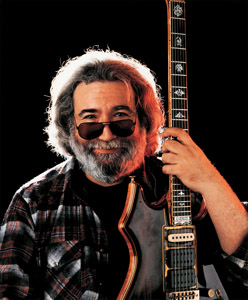Any protagonist cast upon a storm-tossed sea will have some appeal to those of us who rely on ferries as our primary mode of transportation.

Jerry Garcia of the Grateful Dead passed away on August 9, 1995. Photo by Herb Greene
By Paul Duclos
Published: March, 2013
Any protagonist cast upon a storm-tossed sea will have some appeal to those of us who rely on ferries as our primary mode of transportation. But haven’t we all encountered the occasional rascal who deserves to be cast out of the boat when things get rough?
That would be Peer Gynt, the narcissist lead in the musical masterpiece scored by Edvard Hagerup Grieg. When the San Francisco Symphony staged the piece last month, we were delighted to discover Joélle Harvey, who appeared here most recently last month in performances of Messiah, playing Solveig—the ever-loyal soulmate who, despite all challenges, continues to remain faithful to this scoundrel.
Harvey is a brilliant singer, and no doubt has a bright future. The chorus was in fine form, too, and Michael Tilson Thomas did his usual brilliant job of conducting.
The existential trials of this wanderer are not too unlike the modern day meanderings of some of our most iconic rock musicians. Would it be too much of a stretch to suggest Jerry Garcia of the Grateful Dead? Along with Bob Weir, Phil Lesh, and lyricist Robert Hunter, he wrote "Truckin"—a song recognized by the United States Library of Congress as "a national treasure."
Speaking of which, in another bold move fashioned to attract younger and more diverse audiences, the symphony will honor Garcia as part of its "Summer & the Symphony" series. Vocalist and guitarist Warren Haynes, mostly known for his work with the Allman Brothers Band and Government Mule, will join the orchestra in performing new arrangements of Garcia’s music and interpretations of Grateful Dead classics on August 1 (Garcia’s birthday) and 2. Tickets are said to be going fast. www.sfsymphony.org
As we mentioned in our last column, the 46th California International Antiquarian Book Fair in San Francisco attracts a great many lovers of literature, poetry and nonfiction. It also brings in comic book fanatics. In fact, the San Francisco Cartoon Museum was well represented, and was promoting a current show that should be of interest to anyone who admires fine, detailed drawing and storytelling.
In fall 1982, Fantagraphics published its first issue of Love and Rockets, a black-and-white magazine featuring stories and art by the brothers Jaime, Gilbert and Mario Hernandez, also known as Los Bros. Hernandez. These early comics, informed by the brothers’ love of Archie comics, science fiction, punk rock and their own SoCal Latino heritage, laid the foundation for one of the most ambitious, influential and acclaimed indie comic series of all time.
According to museum curator Andrew Farago, it’s hard to overstate the impact that Love and Rockets has had on independent comics over the past three decades. "Small-press comics began with the underground comics boom of the 1960s and gained traction in comic book specialty shops in the 1970s with the success of Dave Sim’s Cerebus and Wendy and Richard Pini’s Elfquest," he said.
In the 1980s, Love and Rockets kicked off an entirely new alternative comics scene. Los Bros. blended high comedy with high drama, juxtaposed magical realism with stark reality, and explored interpersonal relationships with rare sensitivity and insight. The exhibit runs through March 10. www.cartoonart.org
Ferry lovers who wish to jump ship into San Francisco’s rowdy past are encouraged to visit the Conservatory of Flowers in Golden Gate Park this month. Here, you will discover an all-new garden railway display celebrating San Francisco’s gold rush days and its infamous Barbary Coast neighborhood.
The exhibit, which runs through April 14, offers an enchanting display. Landscaped with hundreds of dwarf plants and several water features, model trains wend their way along miniature docks crowded with replicas of the clipper ships that brought fortune seekers to California, then zip past whimsical recreations of the City’s most important landmarks of the day, including Portsmouth Square, Chinatown’s Waverly Place and Maiden Lane—where many a greenhorn was parted from his gold. Boomtown: Barbary Coast, the historic conservatory’s 5th Annual Garden Railway, introduces an entirely new layout that brings to miniature life the colorful history of the city after the 1848 discovery of gold at Sutter’s Mill. Fewer than 500 people lived in San Francisco before James Marshall found gold in the American River, but over the next year, the population would double every ten days, and more than 600 ships would sail through the Golden Gate, bringing thousands of treasure hunters to California.

